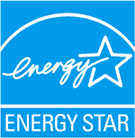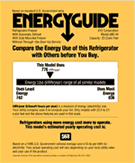Water Heaters
Get Rebates,
Incentives & Services
Introduction
Consumers tend to overlook the expense of heating water for their daily needs, even though 15% of each household's energy dollar goes to heat water. Using less hot water is one of the easiest ways to decrease your water heater's energy output and lower your bills. If your water heater is less than 12 years old, follow these easy, low-cost tips for using your water heater more efficiently.
If your water heater is more than 12 years old, consider replacing it with a new unit (the last two digits of the heater's serial number usually represent the year of manufacture). Some utilities offer rebates on new, energy-efficient models. Also, in 2009 & 2010, the Federal Government is offering a tax credit of 30% of the cost of qualified water heaters, up to $1,500. Today's water heaters are vastly more energy efficient than older models. Water heater efficiency is reported in terms of the energy factor (EF). The higher the EF, the more efficient the water heater.
Seventy-nine percent of households in California use natural gas to heat water. Homes that rely on electricity to heat water might consider looking for a heat pump water heater, which will be available later in 2009. This exciting new technology uses one-third to one-half as much electricity as a conventional electric resistance water heater and can save the average household almost $300 per year.
Technology Options
Ranging in size from 20 to 120 gallons (75.7 to 456 liters), storage water heaters are the most popular type of residential water heaters used in the United States — and also the least efficient. A storage heater keeps a tank full of water heated at all times, which causes energy to be wasted even when the unit is idle. This is called standby heat loss. Newer, more energy-efficient storage models can reduce the amount of standby heat loss, making them less expensive to operate.
When shopping for a new water heater, consider a demand or instantaneous water heater, which uses electricity or gas to heat water instantaneously and has no storage tank, thereby eliminating standby loss and reducing energy consumption 20 to 30%. Cold water travels through a heat exchanger in the unit, and either a gas burner or an electric element heats the water as needed. Demand water heaters make the most sense in homes with natural gas and easily coordinated water requirements. Look for a model with electronic ignition to save the energy consumed by a continuously burning pilot light. Because of the compact size of this type of water heater, very large homes may need more than one to satisfy demand.
Heat-pump water heaters are another efficient way to produce hot water, with possible savings of up to $200 per year. However, this type of system has a high initial cost. Heat-pump water heaters use electricity to move heat from one place to another instead of generating heat directly. They work like a refrigerator in reverse, using the surrounding air as a heat source and delivering heat to the water in the tank. Heat pump water heaters can be purchased as integral units with built-in water storage tanks or as add-ons that can be retrofitted to an existing water heater tank. This system offers the added benefits of dehumidifying the air (helpful in damp locations) and cooling to supplement a home's air conditioning system. The downside is the water heater may add minor heat load to conditioned spaces in the heating season. Since heat pump water heaters use the surrounding air as a heat source, consult the manufacturer for proper application. There may be temperature and airflow requirements to allow the unit to perform well.
A home's space-heating system can also be used to heat water. Two types of water heaters that use this system are tankless coil and indirect. No separate storage tank is needed in the tankless coil water heater because water is heated directly inside the boiler in a hydronic (i.e., hot water) heating system. The water flows through a heat exchanger in the boiler whenever hot water is needed. During colder months, the tankless coil works well because the heating system is used regularly. However, the system is less efficient during warmer months and in warmer climates when the boiler is used less frequently.
A separate storage tank is required with an indirect water heater. Like the tankless coil, the indirect water heater circulates water through a heat exchanger in the boiler. This heated water then flows to an insulated storage tank. Because the boiler does not need to operate frequently, this system is more efficient than the tankless coil. In fact, when an indirect water heater is used with a highly efficient boiler, the combination may provide one of the least expensive methods of water heating.
Through specially designed systems, energy from the sun can be used to heat water for your home with a solar water heater. Depending on climate and water use, a properly designed, installed, and maintained solar water heater can meet from half to nearly all of a home's hot water demand.
Most solar water heaters have a collector and a storage tank. The systems can be classified as passive or active and as direct (also called open loop) or indirect (also called closed loop). Passive systems operate without pumps and controls and can be more reliable, more durable, easier to maintain, longer lasting and less expensive to operate than active systems. Active solar water heaters incorporate pumps and controls to move heat-transfer fluids from the collectors to the storage tanks. Both active and passive solar water-heating systems often require conventional water heaters as backups, or the solar systems function as preheaters for the conventional units.
A direct solar water-heating system circulates household water through collectors and is not appropriate in climates in which freezing temperatures occur. An indirect system should not experience problems with freezing because the fluid in the collectors is usually a form of antifreeze and is isolated in a separate loop of the system.
Efficiency Rating
The best indicator of a water heater's efficiency is its Energy Factor (EF). The EF is based on recovery efficiency (i.e., how efficiently the heat from the energy source is transferred to the water), standby losses (i.e., the percentage of heat lost per hour from the stored water compared to the heat content of the water), and cycling losses.
The higher the EF, the more efficient the water heater. In California, electric resistance water heaters have a minimum EF of 0.97; gas-fired storage, 0.67; oil-fired storage, 0.59; gas-fired instantaneous, 0.62; and electric instantaneous, 0.93. Although electric heaters are more efficient, electricity is typically three times as expensive as natural gas, which may make electric water heaters more expensive to operate for the same water heating load.
The Solar Rating and Certification Corporation rates solar water heaters with a solar energy factor (SEF) ranging from 1.0 to 11. Systems with SEFs of 2 or 3 are the most common. Consult the Solar Rating and Certification Corporation (SRCC) directory to find a system's rating. Another solar water heater performance metric is the solar fraction (SF) which varies from 0 to 1.0. The larger the solar fraction, the more heat gained from the sun. The higher the solar fraction, the greater the solar contribution to water heating reducing the energy required by the back up equipment. Typical SFs are 0.5 to 0.75.
Tankless coil water heaters, combined with boilers, may have a combined appliance efficiency rating (CAE). The CAE may vary from 0.59 to 0.90. When comparing these combination space/water heater systems, look for the highest CAE available.
Efficiency Benefits
Most water heaters today perform better than ones manufactured years ago and most cost significantly less to run than older models. The savings come primarily from reduced heat loss, thanks to added insulation and other technological improvements.
The following savings estimates from ENERGY STAR, were calculated based on the average household size of 2.6 people.
| Water Heater Technology | Average Annual Savings |
| High-efficiency gas storage | $30 |
| Gas Condensing | $110 |
| Whole-Home Gas Tankless | $115 |
| Solar | $220 |
| Heat Pump | $290 |
For more information on the latest efficient water technology, visit the ENERGY STAR page on water heaters.
Going Solar
The money saved from switching to a solar water heater can be substantial. Typically, a homeowner relying on electricity to heat water could save up to $220 in the first year of operation by installing a solar water heating system. The savings over time increases as electricity rates rise. The average solar heating system pays for itself in four to seven years. Visit the CEC's solar hot water system page, and the Solar Rating and Certification Corporation for more information.
Maximizing Efficiency
You can also maximize your energy savings by paying attention to where you use your hot water, and by taking efficiency steps to reduce water use. This chart from the Department of Energy, shows where most hot water is used in the home.
| Activity | Gallons per Use |
| Clothes washing | 32 |
| Showering | 20 |
| Bathing | 20 |
| Automatic dishwashing | 12 |
| Preparing food | 5 |
| Hand dishwashing | 4 |
Manufacturers
For more information on water heater performance, visit the Air Conditioning, Heating, and Refrigeration Institute (AHRI) website, which includes a directory of oil, gas, heat pump and electric water heaters.
Solar water heater manufacturers include Solar Direct, Apricus, and Heliodyne.
Purchasing Tips
|
||||||||||||||||||











